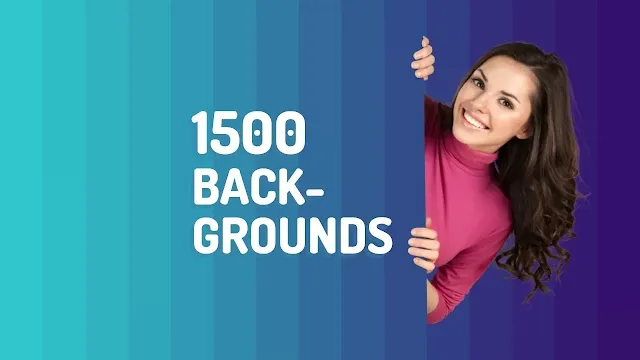1500 High Resolution Backgrounds | Royalty-Free
If you're looking for some amazing backgrounds to use in your next project, look no further than this collection of royalty-free High-Resolution Backgrounds. With a variety of styles to choose from, including gradient, polygon, watercolor, marble, paint, and galaxy, there's sure to be something here that will fit your needs. And best of all, these backgrounds are all free to download and use!
Check the download link at the end of this article!!
As a graphic designer, one of the most important things you can do is choose the right background for your work. The background should be complementary to the foreground and help to create a cohesive overall design.
There are a few things to keep in mind when choosing a background for your graphic design work.
First, consider the color palette of the foreground elements. The background should not clash with or overwhelm these colors. Instead, it should provide a nice contrast that helps to make the foreground elements pop.
Next, think about the overall tone of the piece. Is it playful and lighthearted? Serious and professional?
The background should reflect this tone so that it doesn't jar with the rest of the design. Finally, keep in mind the message you're trying to communicate with your design. The background should support this message rather than detract from it.
For example, if you're designing an advertisement for a new product, you wouldn't want to use a busy patterned background that would make it difficult for people to focus on the product itself. By keeping these factors in mind, you can choose a background that will perfectly complement your graphic design work and help you create stunning designs that communicate your message clearly and effectively!
First, consider the color palette of the foreground elements. The background should not clash with or overwhelm these colors. Instead, it should provide a nice contrast that helps to make the foreground elements pop.
Next, think about the overall tone of the piece. Is it playful and lighthearted? Serious and professional?
The background should reflect this tone so that it doesn't jar with the rest of the design. Finally, keep in mind the message you're trying to communicate with your design. The background should support this message rather than detract from it.
For example, if you're designing an advertisement for a new product, you wouldn't want to use a busy patterned background that would make it difficult for people to focus on the product itself. By keeping these factors in mind, you can choose a background that will perfectly complement your graphic design work and help you create stunning designs that communicate your message clearly and effectively!
Where Do You Find Graphic Design Backgrounds?
There are a few different ways that you can find graphic design backgrounds. One way is to look for them online. You can search for freebies or you can purchase backgrounds from sites like Creative Market.
Another way to find graphic design backgrounds is to create them yourself using Photoshop or another image editing program. Finally, you can also buy pre-made background packs from sites like GraphicRiver.
Another way to find graphic design backgrounds is to create them yourself using Photoshop or another image editing program. Finally, you can also buy pre-made background packs from sites like GraphicRiver.
What Background Do You Need for Graphic Design?
If you're thinking about a career in graphic design, you might be wondering what kind of background you need. The good news is that there is no one specific path to becoming a graphic designer. However, there are some skills and knowledge that will help you succeed in this field.
Here's an overview of what you need to know to become a successful graphic designer. First and foremost, you'll need creativity and imagination. Graphic designers create visual concepts, using computer software or by hand, to communicate ideas that inspire, inform, and captivate consumers.
They develop the overall layout and production design for various applications such as advertisements, brochures, magazines, and corporate reports. Good graphic designers have a strong sense of color, typography, and composition. In addition to creativity, graphic designers also need strong technical skills.
You'll need to be proficient with industry-standard design software such as Adobe Photoshop, Illustrator, and InDesign. Familiarity with web development tools such as HTML5 and CSS3 is also helpful. And although it's not required, having some experience with motion graphics or video editing software can be beneficial for certain types of design projects.
Beyond having the right skill set, it's also important to have the right mindset for success in this field. Graphic design can be a competitive industry so it's important to have confidence in your abilities and be willing to put in the hard work required to succeed. You should also be open to feedback from clients or employers, after all, they're the ones who will ultimately be judging your work!
Here's an overview of what you need to know to become a successful graphic designer. First and foremost, you'll need creativity and imagination. Graphic designers create visual concepts, using computer software or by hand, to communicate ideas that inspire, inform, and captivate consumers.
They develop the overall layout and production design for various applications such as advertisements, brochures, magazines, and corporate reports. Good graphic designers have a strong sense of color, typography, and composition. In addition to creativity, graphic designers also need strong technical skills.
You'll need to be proficient with industry-standard design software such as Adobe Photoshop, Illustrator, and InDesign. Familiarity with web development tools such as HTML5 and CSS3 is also helpful. And although it's not required, having some experience with motion graphics or video editing software can be beneficial for certain types of design projects.
Beyond having the right skill set, it's also important to have the right mindset for success in this field. Graphic design can be a competitive industry so it's important to have confidence in your abilities and be willing to put in the hard work required to succeed. You should also be open to feedback from clients or employers, after all, they're the ones who will ultimately be judging your work!
What is Background in Graphic Design?
Background in graphic design refers to the various elements that make up the overall design of a project. This includes the colors, images, textures, and patterns used. It is important to carefully select each element to create a cohesive design.
The background can either be a single color or multiple colors. It can also be an image or pattern. When choosing an image, it is important to consider the mood you want to convey with your design.
For example, using a photo of a sunset would create a different mood than using a photo of a cityscape. Textures can also be used in the background. This could include things like fabric, paper, or even wood grain.
Again, it is important to consider the mood you are trying to create with your design when selecting textures. Patterns are another element that can be used in backgrounds. These could be geometric shapes, stripes, or even polka dots.
The background can either be a single color or multiple colors. It can also be an image or pattern. When choosing an image, it is important to consider the mood you want to convey with your design.
For example, using a photo of a sunset would create a different mood than using a photo of a cityscape. Textures can also be used in the background. This could include things like fabric, paper, or even wood grain.
Again, it is important to consider the mood you are trying to create with your design when selecting textures. Patterns are another element that can be used in backgrounds. These could be geometric shapes, stripes, or even polka dots.
How Do I Create a Graphic Background?
Assuming you would like a graphic background for a web page:
- Find an image you would like to use or create one in Photoshop.
- Save the image as a .jpg file
- Upload it to your web server.
Types of Background Designs
There are a few different types of background designs that you can use on your website or blog. Each has its own unique look and feel, so it’s important to choose the right one for your needs.
1. Solid Color Backgrounds
Solid color backgrounds are just that – a single, solid color. This type of background is simple and easy to use but can be dull if not used correctly. Choose a color that compliments your content, and make sure there is enough contrast so that text is easy to read.2. Gradient Backgrounds
Gradient backgrounds are created by combining two or more colors together, usually in a fading effect. This type of background can add some visual interest to your site without being too busy or overwhelming. Make sure to choose colors that work well together and create a smooth transition between them.3. Patterned Backgrounds
Patterned backgrounds are becoming increasingly popular as they can add a lot of personality to your site. There are literally thousands of patterns available online, so you’re sure to find one that suits your style perfectly. Just be careful not to choose a pattern that’s too busy or difficult to read against.
4. Image Backgrounds
Image backgrounds are another great way to personalize your site and make it stand out from the crowd.How to download the FREE background Mega Pack?
This specific mega pack contains 1500 background images including gradient, polygon, watercolor, marble, paint, galaxy, and square. You can download this file for free from the link given below. To use this file you need to extract this file.
Password to extract file: isolveit.xyz
Conclusion
There are many different types of backgrounds that can be used for graphic design purposes. Some common background choices include solid colors, gradient colors, images, and textures. When choosing a background, it is important to consider the overall look and feel of the design, as well as the message that you want to convey.
Backgrounds can make or break a design, so it is important to choose wisely!
Backgrounds can make or break a design, so it is important to choose wisely!





.jpg)
